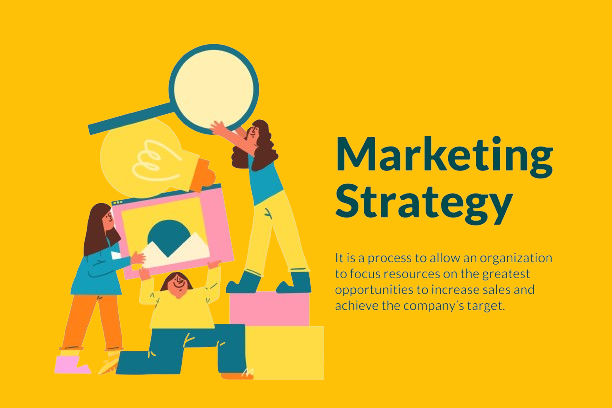Digital Marketing Strategies
In the fast-paced and competitive world of digital marketing, acquiring clients is both an art and a science. As a digital marketing professional, your ability to attract and retain clients directly impacts your success. In this blog post, we’ll explore proven Digital Marketing Strategies for effective client acquisition in the dynamic realm of digital marketing.

Craft a Compelling Online Presence

Crafting a compelling online presence involves strategically curating and presenting a digital identity that captivates and resonates with the target audience. It goes beyond a mere online representation and focuses on creating a powerful, cohesive, and memorable image that leaves a positive impression on visitors. This process encompasses various elements:
Website Optimization: Ensuring that your website is not only visually appealing but also user-friendly and informative. This involves optimizing the design, layout, and content to create a seamless and engaging user experience.
Professional Branding: Developing a consistent and professional brand image across all online platforms. This includes a cohesive logo, color scheme, and messaging that reflect your identity and values.
Content Quality and Relevance: Providing valuable, relevant, and high-quality content that aligns with your expertise. This could involve blog posts, articles, case studies, or any form of content that showcases your knowledge and offers solutions to your audience.
Social Media Presence: Actively participating in relevant social media platforms and consistently sharing content that resonates with your target audience. Engaging with your audience, responding to comments, and participating in industry discussions are crucial aspects.
Professional Profiles: Optimizing professional profiles on platforms like LinkedIn to highlight your skills, experiences, and accomplishments. This not only serves as an online resume but also as a platform to connect with peers and potential clients.
Visual Appeal: Incorporating visually appealing elements such as high-quality images, graphics, and videos that enhance the overall aesthetic of your online presence. Visuals contribute significantly to the first impression you make on visitors.
Responsive Design: Ensuring that your online presence is accessible across various devices and screen sizes. A responsive design enhances the user experience and caters to a broader audience.
Consistent Messaging: Maintaining a consistent and coherent message across all online platforms. Whether it’s your website, social media, or email communication, having a unified voice reinforces your brand identity.
Client Testimonials and Success Stories: Showcasing client testimonials and success stories on your website provides social proof of your capabilities. It builds trust and credibility, assuring potential clients that you have a track record of delivering results.
Engagement and Interactivity: Encouraging engagement by incorporating interactive elements on your website or social media, such as polls, surveys, or comment sections. This fosters a sense of community and connection.
Leverage the Power of Content Marketing

Leveraging the power of content marketing refers to the strategic utilization of content creation and distribution to achieve specific marketing objectives and engage target audiences effectively. Content marketing is a holistic approach that involves crafting and sharing valuable, relevant, and consistent content to attract, inform, and engage a specific audience. Here’s a breakdown of the key components of leveraging the power of content marketing:
-
Strategic Planning: Develop a well-thought-out content marketing strategy aligned with your overall business goals. This involves identifying your target audience, understanding their needs and preferences, and determining the type of content that will resonate with them.
-
Creation of Valuable Content: Produce high-quality content that provides genuine value to your audience. This can take various forms, including blog posts, articles, videos, infographics, podcasts, or any other format that suits your target audience’s preferences.
-
Audience Targeting: Tailor your content to address the specific needs and interests of your target audience. Understanding your audience’s demographics, behaviors, and pain points allows you to create content that resonates and fosters engagement.
-
Consistency Across Platforms: Maintain a consistent brand voice and messaging across all content and platforms. This ensures a unified brand identity and helps build trust with your audience.
-
SEO Optimization: Incorporate search engine optimization (SEO) techniques to make your content discoverable and rank higher in search engine results. This involves using relevant keywords, creating compelling meta descriptions, and optimizing other on-page elements.
-
Multichannel Distribution: Distribute your content across various channels to maximize reach. This includes sharing content on your website, social media platforms, email newsletters, and other relevant channels where your audience is active.
-
Engagement and Interaction: Encourage audience engagement by creating content that prompts likes, shares, comments, and other forms of interaction. Responding to comments and fostering a sense of community around your content enhances its impact.
-
Data Analysis and Iteration: Analyze the performance of your content using metrics such as website traffic, social media engagement, and conversion rates. Use this data to refine your content strategy and make informed decisions for future content creation.
-
Storytelling and Brand Narrative: Infuse storytelling into your content to create a compelling brand narrative. Narratives evoke emotions and help your audience connect with your brand on a deeper level.
-
Lead Generation and Conversion: Utilize content to generate leads and guide your audience through the customer journey. This involves creating content that moves prospects from awareness to consideration and, ultimately, conversion.
Build Strategic Partnerships

“Building strategic partnerships” refers to the intentional and collaborative efforts made by businesses or individuals to form mutually beneficial relationships with other entities. These partnerships are not random or incidental; instead, they are carefully crafted alliances that are aligned with the strategic goals and objectives of the involved parties. Here are key elements that define the process of building strategic partnerships:
-
Shared Objectives: Strategic partnerships are formed when two or more entities share common goals or complementary objectives. These shared objectives become the foundation for collaboration and create a sense of mutual interest.
-
Mutual Benefits: Both parties in a strategic partnership should stand to gain significant advantages from the collaboration. This could include access to new markets, expanded customer bases, cost efficiencies, enhanced capabilities, or other resources that contribute to overall growth.
-
Clear Communication: Effective communication is crucial in building and maintaining strategic partnerships. Transparency about goals, expectations, and potential challenges helps foster trust and ensures that all parties are on the same page throughout the partnership.
-
Complementary Strengths: Successful partnerships often involve entities that bring complementary strengths to the table. Each partner contributes unique resources, skills, or expertise that, when combined, create a more robust and well-rounded offering.
-
Aligned Values and Culture: Compatibility in values and organizational culture is essential for long-term success. Partnerships are more likely to endure and thrive when there is alignment in the way both entities conduct business and treat their stakeholders.
-
Risk and Reward Sharing: In Digital Marketing Strategies partnerships, risks and rewards are shared among the involved parties. This could involve joint investment, collaborative problem-solving, and a shared commitment to overcoming challenges while celebrating successes together.
-
Flexibility and Adaptability: The business landscape is dynamic, and successful strategic partnerships require a level of flexibility and adaptability. Partners should be open to adjusting their Digital Marketing Strategies based on changing market conditions or unforeseen circumstances.
-
Formal Agreements: Formalizing the partnership through legal agreements is a common practice. These agreements outline the terms, responsibilities, and expectations of each party, providing a structured framework for collaboration.
-
Continuous Evaluation and Improvement: Regular assessment of the partnership’s performance ensures that both parties are deriving the expected benefits. This ongoing evaluation allows for adjustments, improvements, and the identification of new opportunities for collaboration.
-
Long-Term Perspective: While some partnerships may be formed for specific projects or initiatives, the most impactful strategic partnerships often have a long-term perspective. Building relationships with a focus on sustainability and growth fosters enduring success.
Implement Targeted Advertising Campaigns

“Implementing targeted advertising campaigns” refers to the strategic planning, execution, and management of advertising initiatives designed to reach a specific audience segment. This approach involves tailoring ad content and delivery based on various factors such as demographics, interests, behaviors, and other relevant criteria to ensure the most effective and efficient use of advertising resources. Here are key elements that define the process of implementing targeted advertising campaigns:
Audience Segmentation: Identify and segment your target audience based on relevant characteristics such as age, gender, location, interests, purchasing behavior, or other demographic and psychographic factors. This segmentation forms the foundation for personalized and targeted advertising.
Data Analysis and Insights: Utilize data analysis tools to gather insights into your target audience’s behaviors, preferences, and online activities. This data-driven approach helps in understanding the most effective channels, ad formats, and messaging to engage your audience.
Clear Campaign Objectives: Define specific and measurable objectives for your advertising campaign. Whether it’s increasing brand awareness, driving website traffic, generating leads, or boosting sales, having clear objectives allows for better alignment with targeted Digital Marketing Strategies.
Tailored Ad Content: Create ad content that resonates with the identified audience segments. Tailor your messaging, visuals, and calls-to-action to address the specific needs, interests, and pain points of each segment.
Choice of Advertising Channels: Select the most relevant and effective advertising channels to reach your target audience. This could include social media platforms, search engines, display networks, email, or other online and offline channels based on where your audience is most active.
Geo-Targeting: Implement geo-targeting to deliver ads to users in specific geographic locations. This ensures that your advertising efforts are focused on areas where your target audience is concentrated or where your products or services are most relevant.
Behavioral Targeting: Leverage behavioral targeting to reach users based on their online activities and past behaviors. This includes factors such as browsing history, search queries, and interactions with previous ads.
Retargeting Campaigns: Implement retargeting or remarketing campaigns to re-engage users who have previously interacted with your website or ads. This helps reinforce your brand and encourages users to take desired actions.
Budget Optimization: Allocate your advertising budget strategically across different segments and channels based on their performance. Regularly monitor the campaign’s effectiveness and adjust budget allocations to optimize results.
Performance Tracking and Analytics: Utilize analytics tools to track the performance of your targeted advertising campaigns. Measure key performance indicators (KPIs) such as click-through rates, conversion rates, and return on investment (ROI) to assess the success of your efforts.
Offer Free Workshops or Webinars

“Offering free workshops or webinars” involves the provision of educational and informative sessions that are accessible to participants at no cost. These events are typically conducted online, leveraging webinar platforms or workshop hosting tools, and are designed to share valuable knowledge, insights, or skills on a specific topic. Here are key elements that define the concept of offering free workshops or webinars:
-
Educational Content: The primary purpose is to deliver educational content that addresses a specific subject, industry trend, or skill set. Workshops or webinars aim to provide valuable information and insights to participants.
-
No Cost to Participants: Participation in these events is free of charge for attendees. This inclusivity encourages a broader audience to join, removing financial barriers and making the content accessible to a diverse group of individuals.
-
Online Delivery: Workshops and webinars are typically conducted through online platforms, allowing participants to join remotely from anywhere with an internet connection. This format enhances accessibility and convenience.
-
Interactive Engagement: Workshops and webinars often include interactive elements such as Q&A sessions, polls, quizzes, or discussions. This engagement fosters participant involvement and enhances the learning experience.
-
Expert Presenters: The sessions are typically led by experts or professionals in the field, ensuring that participants receive high-quality and credible information. The expertise of the presenter adds value to the content being shared.
-
Registration Process: Participants are usually required to register for the workshop or webinar in advance. This registration process helps organizers manage attendance, send reminders, and gather participant information for follow-up communications.
-
Promotion and Marketing: Organizers promote the event through various channels such as social media, email newsletters, and websites. Effective marketing ensures that the target audience is aware of the workshop or webinar and encourages participation.
-
Recorded Sessions: In some cases, organizers may choose to record the workshop or webinar for future access. This allows participants to revisit the content, and it can be repurposed for those who couldn’t attend the live session.
-
Resource Materials: Organizers often provide supplementary materials, such as presentation slides, handouts, or additional resources, to further support participants’ understanding of the topic.
-
Networking Opportunities: Workshops and webinars may include networking components, allowing participants to connect with each other, ask questions, and share insights. Networking enhances the overall experience and can foster a sense of community.
Optimize Your LinkedIn Profile

To “optimize your LinkedIn profile” means Digital Marketing Strategies enhancing and fine-tuning various elements of your LinkedIn profile to present a professional and compelling image. LinkedIn is a powerful platform for professional networking and personal branding, and optimizing your profile ensures that it effectively communicates your skills, experiences, and achievements. Here’s a breakdown of key elements to focus on when optimizing your LinkedIn profile:
Profile Photo:
- Upload a professional and high-quality profile photo. Choose an image that presents you in a positive and approachable manner. Ensure that the photo is recent and aligns with your professional image.
Headline:
- Craft a concise and impactful headline that communicates your current role, expertise, or key skills. Use keywords relevant to your industry to enhance discoverability in LinkedIn searches.
Summary:
- Write a compelling and well-crafted summary that provides an overview of your professional journey, skills, and aspirations. Use this space to showcase your personality and what sets you apart.
Experience:
- Detail your professional experience, focusing on achievements and outcomes. Use action verbs and quantify your accomplishments wherever possible. Highlight key responsibilities and contributions in each role.
Skills and Endorsements:
- List relevant skills that showcase your expertise. Seek endorsements from colleagues or connections to validate your proficiency in these skills. Regularly update and refine your skill set based on your evolving strengths.
Recommendations:
- Request and display recommendations from colleagues, managers, or clients. Genuine testimonials provide credibility and offer insights into your professional relationships.
Custom LinkedIn URL:
- Personalize your LinkedIn URL to make it easy to share and remember. A clean and customized URL enhances your professional branding.
Education and Certifications:
- Include information about your educational background and any relevant certifications. Highlight academic achievements, honors, and any additional qualifications that strengthen your professional profile.
Projects and Publications:
- Showcase any notable projects or publications you have been involved in. This provides depth to your profile and demonstrates your contributions to your field.
Volunteer Experience:
- If applicable, include details about your volunteer experiences. This not only highlights your commitment to community and causes but also adds a personal touch to your professional story.
Connections:
- Actively connect with colleagues, peers, mentors, and industry professionals. A robust network enhances your visibility and provides opportunities for meaningful professional interactions.
Activity and Engagement:
- Engage with your network by sharing relevant content, commenting on posts, and participating in discussions. Regular activity on LinkedIn demonstrates your industry knowledge and keeps you visible to your connections.
Settings and Privacy:
- Adjust your privacy settings to control what information is visible to others. Ensure that your contact information, particularly your professional email, is up-to-date.
Follow Influencers and Companies:
- Follow thought leaders and companies relevant to your industry. This not only keeps you informed but also shows your interests and engagement within your professional community.
Implement a Referral Program

To “implement a referral program” means establishing and executing a structured system that encourages and rewards individuals or existing customers for recommending and bringing in new clients, customers, or contacts to a business or service. Referral programs are a Digital Marketing Strategies approach to leverage existing networks and relationships to expand customer bases, increase brand awareness, and drive business growth. Here are key components that define the process of implementing a referral program:
Program Design:
- Clearly define the objectives of your referral program. Determine what specific actions or results you want to achieve, whether it’s acquiring new customers, generating leads, or increasing sales.
Incentives and Rewards:
- Decide on the incentives or rewards offered to those who refer new clients or customers. This could include discounts, exclusive access, monetary rewards, loyalty points, or other tangible benefits.
Referral Tracking System:
- Implement a reliable system to track referrals accurately. This system should capture information about the referrer, the referred customer, and the successful conversion or sale attributed to the referral.
Promotion and Communication:
- Effectively communicate the referral program to your existing customers, clients, or network. Utilize various channels such as email newsletters, social media, and website announcements to spread awareness about the program.
Clear Call-to-Action:
- Clearly communicate the steps for making a referral. Provide an easy and accessible way for referrers to share information or invite their contacts to engage with your business.
Customizable Referral Links:
- Offer unique referral links or codes for each referrer. This allows for accurate tracking of referrals and ensures that the rewards are attributed to the right individuals.
Automated Processes:
- Implement automation where possible to streamline the referral process. This includes automated tracking, reward delivery, and communication to enhance efficiency and accuracy.
Transparency and Trust:
- Build trust by being transparent about the referral program’s terms, conditions, and reward structures. Clearly outline how the program benefits both the referrer and the referred.
Targeted Outreach:
- Identify key individuals or segments within your existing customer base who are likely to be enthusiastic referrers. Targeted outreach can maximize the impact of your referral program.
Regular Updates and Recognition:
- Keep referrers informed about the progress of their referrals and acknowledge their contributions. Regular updates and public recognition can motivate ongoing participation.
Feedback Mechanism:
- Establish a system for collecting feedback from both referrers and referred customers. This feedback can provide valuable insights for refining and optimizing the referral program over time.
Adaptability and Iteration:
- Monitor the performance of the referral program and be willing to adapt based on results. Periodically assess the effectiveness of the program and make adjustments to enhance its impact.
Showcase Case Studies and Testimonials

To “showcase case studies and testimonials” involves presenting real-life examples and feedback from satisfied clients or customers to demonstrate the success, effectiveness, and positive experiences associated with a product, service, or business. This approach is a powerful marketing strategy as it provides tangible evidence of the value delivered and builds credibility and trust among potential customers. Here are key elements that define the process of showcasing case studies and testimonials:
-
Case Studies:
- Definition: Case studies are in-depth examinations of specific projects, experiences, or situations where a product or service was successfully implemented to address a particular challenge or achieve specific goals.
- Purpose: The purpose of a case study is to provide a detailed narrative that highlights the problem, solution, and outcomes, showcasing the capabilities and effectiveness of the product or service.
-
Testimonials:
- Definition: Testimonials are statements or endorsements from clients, customers, or users expressing their satisfaction, positive experiences, or opinions about a product, service, or business.
- Purpose: Testimonials serve as concise and authentic endorsements that build trust, credibility, and confidence among potential customers by sharing the positive experiences of others.
-
Presentation Format:
- Case Studies: Typically presented as detailed written documents, infographics, or multimedia presentations. They include background information, the problem or challenge, the solution, and measurable results.
- Testimonials: Can be presented as written quotes, video testimonials, or short statements. They are often concise and highlight the key benefits or positive aspects experienced by the individual.
-
Use of Data and Metrics:
- Case Studies: Incorporate relevant data and metrics to quantify the success or impact of the solution implemented. This adds a layer of objectivity and demonstrates measurable results.
- Testimonials: While not always data-driven, testimonials may include qualitative statements that express satisfaction, improved outcomes, or specific positive aspects experienced by the individual.
-
Targeted Audience:
- Case Studies: Aimed at potential customers or clients who may be facing similar challenges or seeking solutions. They provide a detailed understanding of how the product or service can address specific needs.
- Testimonials: Primarily directed towards a broader audience, including those considering a purchase or looking for social proof of a product or service’s value.
-
Placement in Marketing Collateral:
- Case Studies: Often featured on a company’s website, in marketing materials, or shared during sales presentations to provide in-depth insights into successful implementations.
- Testimonials: Can be strategically placed on product pages, landing pages, or promotional materials to reinforce the credibility and positive reputation of a business.
-
Authenticity and Trust-Building:
- Case Studies: Contribute to building trust by presenting a comprehensive and transparent view of the challenges faced and how they were overcome. Authenticity is key.
- Testimonials: Offer authentic voices of satisfied customers, adding a human touch to the brand and fostering trust among potential customers.
-
Variety and Diversity:
- Case Studies: Showcasing a variety of case studies across different industries, use cases, or challenges adds depth and demonstrates the versatility of the product or service.
- Testimonials: A diverse set of testimonials from various customers or clients adds credibility and allows potential customers to relate to individuals with similar needs or backgrounds.
Conclusion:
Effective client acquisition in digital marketing Strategies blend of showcasing your skills, building relationships, and leveraging various online channels. By implementing these proven Digital Marketing Strategies, you can create a robust client acquisition plan that not only attracts clients but also positions you as a go-to expert in the competitive Digital Marketing Strategies landscape. Remember, building lasting relationships is key, and each successful client acquisition is a step toward building a thriving digital marketing career
